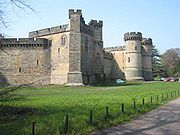
Brancepeth Castle
Encyclopedia

Castle
A castle is a type of fortified structure built in Europe and the Middle East during the Middle Ages by European nobility. Scholars debate the scope of the word castle, but usually consider it to be the private fortified residence of a lord or noble...
in the village of Brancepeth
Brancepeth
Brancepeth is a village and civil parish in County Durham, in England. It is situated about from Durham on the A690 road between Durham and Weardale. Brancepeth Castle was until 1570 the fortress of the Neville Earls of Westmorland. The castle was extensively modified and rebuilt in the 19th century...
in County Durham
County Durham
County Durham is a ceremonial county and unitary district in north east England. The county town is Durham. The largest settlement in the ceremonial county is the town of Darlington...
, England
England
England is a country that is part of the United Kingdom. It shares land borders with Scotland to the north and Wales to the west; the Irish Sea is to the north west, the Celtic Sea to the south west, with the North Sea to the east and the English Channel to the south separating it from continental...
, some 5 miles south-west of the city of Durham
Durham
Durham is a city in north east England. It is within the County Durham local government district, and is the county town of the larger ceremonial county...
. It is a Grade I listed building.
History
A succession of buildings has been on the site. The first was a NormanNormans
The Normans were the people who gave their name to Normandy, a region in northern France. They were descended from Norse Viking conquerors of the territory and the native population of Frankish and Gallo-Roman stock...
castle built by the Bulmers
Bulmer (family)
The Bulmer family were a noble family of Norman England, resident in Yorkshire. The family take their name from Bulmer, North Yorkshire. The name Bulmer comes from English "Bull mere", a lake frequented by a bull, and is an Anglicised form of Gaelic "Búir na mara" from the Celtic tribe Brigantes...
, which was rebuilt by the Nevilles in the late 14th century. For many years the castle was owned by the Neville family until in 1569 it was confiscated by the Crown following the family's involvement in the Rising of the North
Rising of the North
The Rising of the North of 1569, also called the Revolt of the Northern Earls or Northern Rebellion, was an unsuccessful attempt by Catholic nobles from Northern England to depose Queen Elizabeth I of England and replace her with Mary, Queen of Scots.-Background:When Elizabeth I succeeded her...
..
There have been a number of other owners since that time. In the early 17th century the estate was granted by the Crown to Robert Carr, 1st Earl of Somerset
Robert Carr, 1st Earl of Somerset
Robert Carr, 1st Earl of Somerset, , was a politician, and favourite of King James I of England.-Background:Robert Kerr was born in Wrington, Somerset, England the younger son of Sir Thomas Kerr of Ferniehurst, Scotland by his second wife, Janet, sister of Walter Scott of Buccleuch...
, from whom it subsequently confiscated the castle back due to his involvement in a posioning scandal. In 1636, three men who had bought the castle from the King's Commissioners in 1633 sold it to Ralph Cole of Newcastle. His grandson, Ralph Cole MP, sold the property in about 1720 to Sir Henry Belaysyse, whose daughter was involved with Bobby Shafto
Bobby Shafto
Robert Shafto was an 18th-century British Member of Parliament , who was the likeliest subject of a famous North East English folk song and nursery rhyme "Bobby Shafto's Gone to Sea".-Biography:...
and who was said to have inspired the famous song
Bobby Shafto's Gone to Sea
"Bobby Shafto's Gone to Sea" or "Bobby Shafto" is an English language folk song and nursery rhyme. It has a Roud index number of 1359.-Lyrics:The most common modern version is:...
. In 1796 the castle was acquired by the Russells.
The present building is largely a 19th-century restoration carried out in the 1820s by John Matthew Russell and improved in the mid-19th century by architect Anthony Salvin
Anthony Salvin
Anthony Salvin was an English architect. He gained a reputation as an expert on medieval buildings and applied this expertise to his new buildings and his restorations...
for William Russell
William Russell (1798–1850)
William Russell of Brancepeth Castle in County Durham was a British Whig politician. He sat in the House of Commons between 1822 and 1832....
, (High Sheriff of Durham in 1841). During the First World War the castle was used as a hospital by convalescents from Newcastle General Hospital
Newcastle General Hospital
Newcastle General Hospital was for many years the main hospital for the city of Newcastle upon Tyne, England, and is managed by Newcastle upon Tyne Hospitals NHS Foundation Trust...
. It then became the regimental headquarters for the Durham Light Infantry
Durham Light Infantry
The Durham Light Infantry was an infantry regiment of the British Army from 1881 to 1968. It was formed by the amalgamation of the 68th Regiment of Foot and the 106th Regiment of Foot along with the militia and rifle volunteers of County Durham...
, who erected a military camp of over 100 huts to the south of the village during the Second World War.
The castle is now privately owned by the Dobson family, the castle having been purchased by Margaret Dobson, wife of publisher Dennis Dobson, in 1978.
Events
Under the present owners, there is a craft fair twice a year, and two open-air Shakespeare events.Further reading
- Fry, Plantagenet Somerset, The David & Charles Book of Castles, David & Charles, 1980. ISBN 0-7153-7976-3

